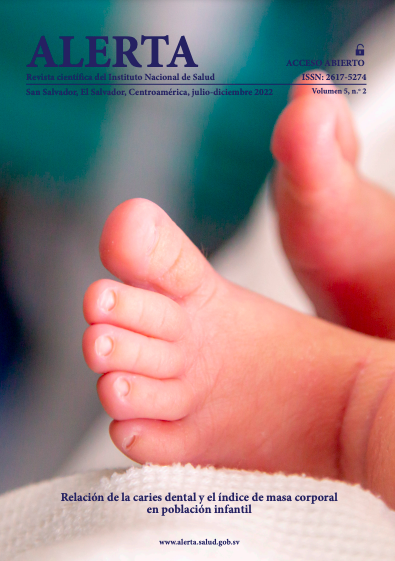Primer caso humano de Rickettsia felis reportado en Guatemala
DOI:
https://doi.org/10.5377/alerta.v5i2.14502Resumen
Estimada Editora:
La infección por Rickettsia felis (R. felis) es considerada una amenaza para la salud humana. La R. felis, una bacteria gramnegativo considerada como un patógeno emergente que ha sido identificada en numerosos casos humanos a nivel global, representa una causa importante de enfermedades febriles, asociada generalmente con Ctenocephalides felis encontrada en gatos y perros1. Las manifestaciones clínicas tempranas incluyen fiebre, dolor de cabeza, mialgia, sarpullido, tos y vómitos, que pueden parecerse a otras enfermedades febriles como dengue y malaria, complicando así el diagnóstico clínico1,2. Sin tratamiento podrían desarrollarse síntomas severos potencialmente letales.
La vigilancia centinela de enfermedades febriles agudas, a través de la Vigilancia Integrada Colaborativa que se desarrolló en Guatemala entre los años 2013 y 20183, permitió el hallazgo del primer caso de Rickettsia felis en Guatemala. Se eligieron 612 pacientes que cumplieron con los criterios de la definición de caso de síndrome febril agudo: consulta médica u hospitalización por fiebre sin causa aparente con evolución menor a siete días, o fiebre cuantificada mayor o igual a 38 °C durante la consulta o durante las primeras 24 horas de hospitalización. Se tomaron las muestras de sangre para el análisis de los agentes causantes de malaria, leptospirosis, dengue y rickettsiosis, que fueron procesadas en los laboratorios de la Universidad del Valle de Guatemala. La muestra positiva para Rickettsia spp. fue analizada por reacción en cadena de la polimerasa (PCR) convencional para la detección del gen de antígeno de Rickettsia 17 kDa, encontrado en el grupo de rickettsias productoras de fiebres maculosas (SFGR) y en el grupo de tifus Rickettsia ADN. Se usó la amplificación semianidada del fragmento nucleótido 70–602 del gen de proteína transmembranal A OmpA de Rickettsia para la identificación de SFGR. Finalmente, el hallazgo fue confirmado por la División de Zoonosis de Rickettsia de los Centros para el Control y Prevención de Enfermedades; donde se confirmó Rickettsia spp., a través de la PCR en tiempo real en la que se utilizó el ensayo PanR8 y por la PCR anidada enfocada en el gen SFG 17 kDa. La secuenciación del producto de amplificación identificó R. felis. La muestra pertenecía a un niño de tres años tratado en diciembre de 2017 en un centro de salud del Municipio de Nueva Santa Rosa, Santa Rosa, en Guatemala. Al momento de la toma de la muestra, el paciente reportaba dos días de fiebre, tos, disnea, vómitos, dolor abdominal y fatiga. Se reportó como factor de riesgo de exposición que su mascota era un gato.
La infección por R. felis puede causar un síndrome febril agudo con síntomas variados1. En algunos casos, es una enfermedad leve sin fiebre; además, se han registrado casos aislados de niños que presentaron erupciones o costras1. La presentación afebril también puede contribuir a la no detección4.
La identificación de esta infección en estudios de vigilancia de enfermedad febril en África y Asia sugiere que produce una enfermedad clínicamente relevante en individuos con inmunosupresión2.
La baja disponibilidad de pruebas diagnósticas es una limitante. Además, al existir una reactividad cruzada de la serología entre las fiebres maculosas de las Montañas Rocosas, hace difícil interpretar los resultados, lo cual limita la utilidad del diagnóstico1. Estudios demuestran evidencia serológica de una exposición diseminada a fiebre de las Montañas Rocosas, coincidiendo con el aislamiento de R. felis5. Por su parte, las pruebas moleculares dan un resultado de especie específica, pero la sensibilidad podría disminuirse con el tiempo y el tratamiento1. Una alta proporción de casos de ensayos de inmunofluorescencia nunca reciben un diagnóstico definitivo.
Los mamíferos no humanos son los reservorios asintomáticos. La escasez de casos humanos notificados en Centroamérica, a pesar de la amplia evidencia documentada de R. felis en vectores artrópodos, sugiere que la enfermedad no está siendo detectada5.
Dada la conocida prevalencia en la región de R. felis en pulgas, es probable que las infecciones humanas por R. felis no estén siendo diagnosticadas y pueden estar entre las causas de ensayos de inmunofluorescencia no diferenciadas. Los ensayos moleculares pueden distinguir entre varias especies de rickettsias, lo que permite una mejor caracterización de estas infecciones4,5. Este hallazgo señala a considerar a R. felis como una etiología en el diagnóstico diferencial de pacientes febriles con síntomas respiratorios, digestivos o no específicos, que puede orientar el tratamiento y la atención médica adecuados. Además, se deben evaluar factores de riesgo potenciales, como el contacto con portadores de pulgas infectadas5.
Aunque en este estudio se detectó solo un caso de R. felis, la carga real en Centroamérica podría estar subregistrada. Se considera importante proponer que las técnicas de laboratorio molecular estén accesibles en la región para brindar una mejor caracterización de la carga de enfermedades por rickettsiosis4.
A pesar de la falta de una muestra de suero convaleciente para confirmar que la respuesta inmune coincidía con la enfermedad aguda, la proximidad a los síntomas agudos, la falta de otra etiología después de realizar pruebas exhaustivas y el resultado positivo en un ensayo con un alto límite de detección, respaldó que la etiología fuera R. felis en la enfermedad febril de este niño. Además, existe una conocida circulación de infección por R. felis en animales domésticos en la misma área geográfica y cada vez hay más evidencia en la literatura de que es una importante fuente de enfermedad febril aguda en niños en África y Asia.
Ampliar la vigilancia permitiría una mejor descripción de la distribución de las enfermedades por rickettsiosis en la población, con las consiguientes mejoras en el manejo clínico y el tratamiento de estas infecciones emergentes. Por tanto, se sugiere una mayor conciencia de la presentación y diagnóstico de este patógeno en Centroamérica, lo cual puede contribuir a una comprensión más completa de la verdadera carga de estas enfermedades en la región.
Descargas
591
PDF (English) 331
Descargas
Publicado
Cómo citar
Número
Sección
Licencia
Derechos de autor 2022 Beatriz López , Jahn Jaramillo , Paige A. Armstrong, Maria Renee Lopez, Arlyn N. Gleaton, Ida H. Chung, Cecilia Y. Kato, Lissette Reyes, Manuel Sagastume, John P. McCracken, Andrés Espinosa- Bode

Esta obra está bajo una licencia internacional Creative Commons Atribución 4.0.
Declaración de privacidad:
Los artículos de Revista Alerta están publicados bajo una licencia creative commons 4.0 CC BY: https://creativecommons.org/licenses/by/4.0/

Los autores conservan todos sus derechos sobre la obra y acuerdan permitir que los artículos sean copiados y distribuidos por cualquier medio, siempre que se mantenga su autoría y reconocimiento de la publicación, sin otras restricciones adicionales.




